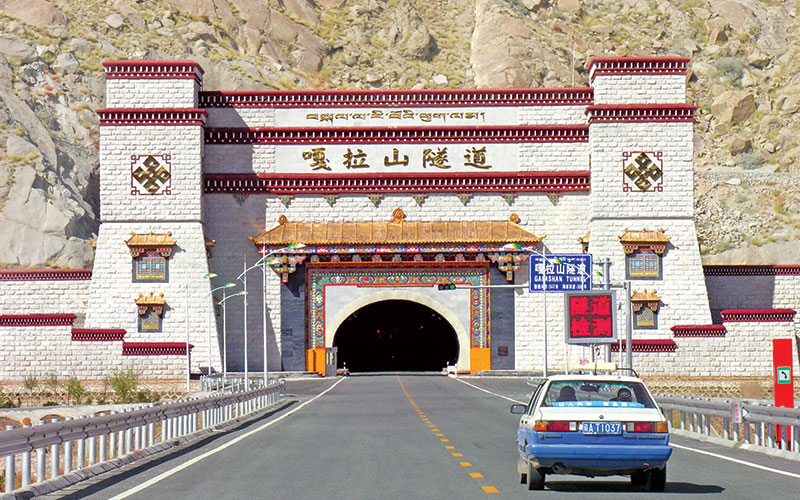PLA ground force build-ups during and after Doklam standoff
Prasun K. Sengupta
Except for Ladakh, which lies north of the Himalayas, the de facto Sino-Indian boundary, called the Line of Actual Control (LAC), broadly follows the Himalayan watershed. The commonest form of dispute — and there are 14 separate disputes along the LAC — is whether one ridgeline, or the neighbouring one, constitutes the watershed.

The 1962 war was sparked off near Zimithang by disagreement over whether the boundary ran along the Thagla Ridge, as India claimed, or along the Hathung La ridgeline to its south, as China contended. The 1986 Sumdorong Chu confrontation, which saw India moving tens of thousands of troops to the trouble spot under ‘Operation Falcon’, was over the tiny Thangdrong grazing ground near Tawang, with India claiming that the watershed ran north of that meadow, and China claiming that it was to the south.
At Walong too, at the eastern-most end of the LAC, disagreement centres on which ridgeline constitutes the watershed. These small disputes over the alignment of the LAC are sub-sets of a major overarching territorial dispute — in which China claims all of Arunachal Pradesh (Southern Tibet, according to Beijing); and India claims the Aksai Chin plateau. Many of the 14 sub-disputes on the LAC are over relatively inconsequential grazing grounds and meadows.
Origins of Standoff
China’s territorial claim to the contested area in the Doklam Plateau rests on an 1890 treaty, the Convention between the United Kingdom (UK) and China Relating to Sikkim and Tibet. At that time, Sikkim was a British protectorate and India was a British colony.
Today, Sikkim is part of an independent India. A lot of water has flowed under the bridge and yet China pins its claim on this relatively ancient treaty. The boundary convention signed in 1890 explicitly stipulates that Mount Gipmochi is the junction of China, India and Bhutan, and Doklam is situated on the Chinese side of the China-India and China-Bhutan boundaries.
Actually, the 1890 treaty is by no means clear. While the treaty says that the line between Sikkim and Tibet ‘commences at Mount Gipmochi on the Bhutan frontier,’ it also says that the boundary ‘shall be the crest of the mountain range separating the waters’ that flow southward into Sikkim and northward into Tibet. Unfortunately for China, Mount Gipmochi is not at ‘the crest of the mountain range separating the waters.’ That location, it turns out, is Batang La. Article 1 states that the border begins at Mount Gipmochi, roughly 3km south of the Chinese road and the western point of the Jampheri Ridge. It also states that the boundary will follow the watershed.
Unfortunately, however, Mount Gimpochi is not the start of the watershed, and the convention did not explain how to square this circle. The convention thus contains a contradiction that allows each side to claim it supports its own position. Sometime between 1907 and 1913, the UK published a map of the area showing the border starting at Batang La, 6km north of Mount Gipmochi. So, if Gipmochi is the starting point, Doklam is in China but if Batang La is the real starting point, then Doklam is in Bhutan and China has no right to build a road there. India believes the boundary between it, Tibet and Bhutan emanates from the trijunction south of Batang La, moves along the Merug La-Sinche La Point 4421 and then northwest along the Chomo Lhari Ridge. China, however, insists the trijunction is at Gyemochen. India says that it had reached agreement with China in 2012 that the tri-junction boundary points between India, China and third countries will be finalised in consultation with the concerned countries. China is silent on this agreement.
It is interesting that China should put so much emphasis on this 1890 treaty, especially since China’s foreign ministry refers to another treaty with the UK, the Sino-British Joint Declaration on Hong Kong, signed in 1984, as a ‘historical document that no longer has any realistic meaning.’ This announcement was made despite the fact that the Joint Declaration spells out policies regarding Hong Kong for 50 years beyond 1997 and says: ‘The Government of the United Kingdom and the Government of the People’s Republic of China agree to implement the preceding declarations and the Annexes to this Joint Declaration.’ So, on one hand, a treaty that is meant to run at least until 2047 is already irrelevant, while one signed in 1890, when the world was very different, is still binding. China is thus picking carefully — and unilaterally — which treaties it considers relevant.
China’s decision to complete the construction of a road to a watchtower in the Doklam area that it built in 2014 may have triggered the 2017 standoff with India. China, marginalising the Bhutanese military presence, began to gradually exercise physical control over the Doklam area only after 2007. Before that it was controlled by Bhutan. The area was generally inaccessible and was like a no man’s land where China did not exercise actual control. Later on, Bhutan set up watchtowers in the Doklam area and had the actual control. In 2007, China destroyed two seasonal watchtowers set up by Bhutan. Seven years later, the PLA set up the Zhecaochang watchtower, following two years of construction, on the base of the two destroyed Bhutanese watchtowers. This time the very last section of road connecting to Zhecaochang watchtower was supposed to be finished. Besides, the possible destruction of two Indian watchtowers and a self-help bunker below Gurmel OP by China in 2007 (which was not reconstructed thereafter) may have fuelled New Delhi’s ire.
You must be logged in to view this content.

